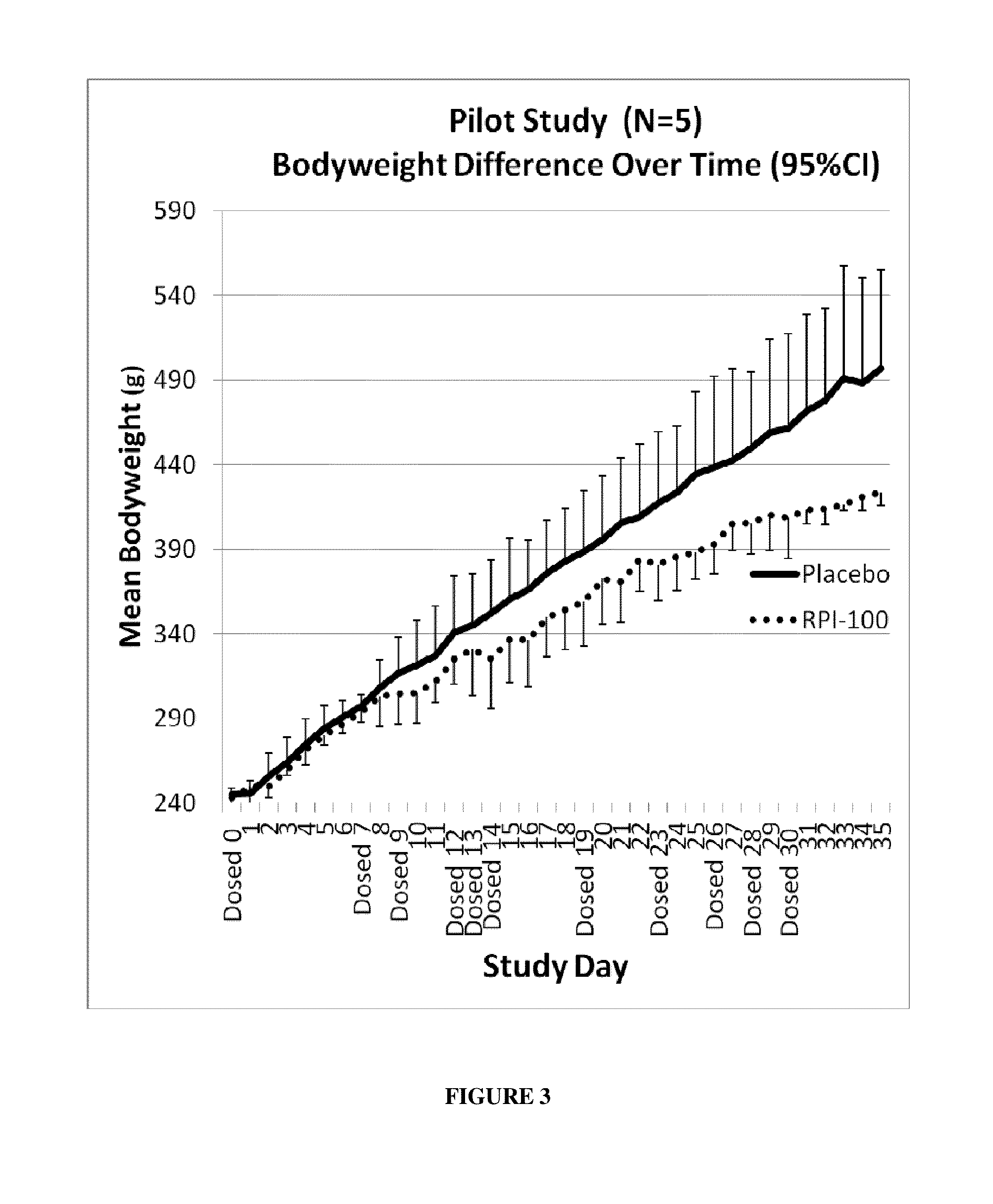Method for treating obesity
a technology of lipids and lipids, applied in the field of rhamnolipids, can solve the problems of obesity, serious health and economic burden, reduced life expectancy and/or increased health problems, etc., and achieve the effect of improving the appearance of celluli
- Summary
- Abstract
- Description
- Claims
- Application Information
AI Technical Summary
Benefits of technology
Problems solved by technology
Method used
Image
Examples
example 1
Objective
[0073]Originally, the objective of this study was to determine the effects of treatment with three different pharmaceutical formulations of rhamnolipids within the context of an allergic rhinitis study in mice. However, the weight loss effects due to treatment with the various rhamnolipids were unexpectedly discovered during the course of this study.
Materials
Animal:
[0074]Balb / C mice were used in this study and were eight weeks old. The treatment groups and the placebo group were each composed of 10 mice. Allergenization was performed in a similar fashion as reported in the literature.
Sensitization Materials:
[0075]The following were used to sensitize and induce allergic rhinitis in the mice:[0076]1. OVA / Alum (0.8 μg and 0.8 mg / mouse, respectively) was used as an intraperitoneal injection. Grade V OVA was from Sigma-Aldrich (St. Louis, Mo.). Alum was aluminum hydroxide gel from Pierce Biotechnology (Rockford, Ill.); now Thermo Fisher Scientific, Inc.)[0077]2. An ovalbumin (OV...
example 2
Objective
[0090]The objective of this study was to explore the effects and feasibility of subcutaneous injections of rhamnolipids at varying concentrations in a human model.
Materials
Subject:
[0091]Human subject: 60 year old male, 108 kg (BMI 29.8) with known hypertension.
Injections:
[0092]Standard insulin syringes (Monoject®) were used for injections.
Rhamnolipids:
[0093]15% (w / v) solution of rhamnolipid: JBL515 was used for the 15% solution of rhamnolipid.
1, 2.5, 5, and 10% (w / v) solution of rhamnolipid: Each solution was prepared by diluting JBL515 (15%) in water.
Methods and Results
Study Part A: Initial Study of Small, Increasing Doses of Rhamnolipid Injections
[0094]The subject injected himself with initial small test doses of approximately 0.5 ml of a 1% solution of rhamnolipids into subcutaneous fatty tissue located in his left lumbar region and his right iliac region.
[0095]As these initial injections were extremely well tolerated with no signs of significant inflammation, a subseque...
example 3
Objective
[0101]The objective of this study was to determine the effects of different treatment intervals and prolonged exposure of rhamnolipids on body weight and parameters of metabolic syndrome in rats.
Materials
Animal:
[0102]Five obese Zucker rats (Charles River Laboratories International, Inc. (Wilmington, Mass.), approximately 8 weeks old, were used in this study.
Rhamnolipids:
[0103]RPI-100 was used in this study.
Saline was used as a placebo for this study.
Methods
[0104]Three rats were treated with interval, subcutaneous injections of RPI-100, while two rats were injected with a placebo. Fixed doses (120 mg / kg body weight) were administered as two 60 mg / kg injections into dorsal fat regions of the rats on a total of 11 days (Study Day 0, 7, 9, 12, 13, 14, 19, 23, 26, 28, 30) (FIG. 3). The sites of injections were alternated with each dose administration. Blood glucose, cholesterol, and triglyceride levels were measured on Day 39, which was 9 days after the last injection of RPI-100...
PUM
| Property | Measurement | Unit |
|---|---|---|
| Weight | aaaaa | aaaaa |
| Body weight | aaaaa | aaaaa |
Abstract
Description
Claims
Application Information
 Login to View More
Login to View More - R&D
- Intellectual Property
- Life Sciences
- Materials
- Tech Scout
- Unparalleled Data Quality
- Higher Quality Content
- 60% Fewer Hallucinations
Browse by: Latest US Patents, China's latest patents, Technical Efficacy Thesaurus, Application Domain, Technology Topic, Popular Technical Reports.
© 2025 PatSnap. All rights reserved.Legal|Privacy policy|Modern Slavery Act Transparency Statement|Sitemap|About US| Contact US: help@patsnap.com



